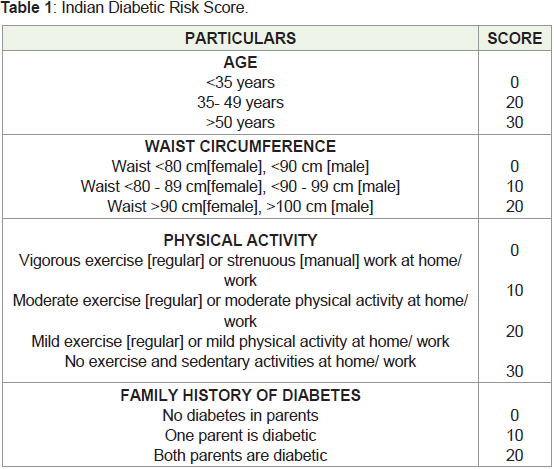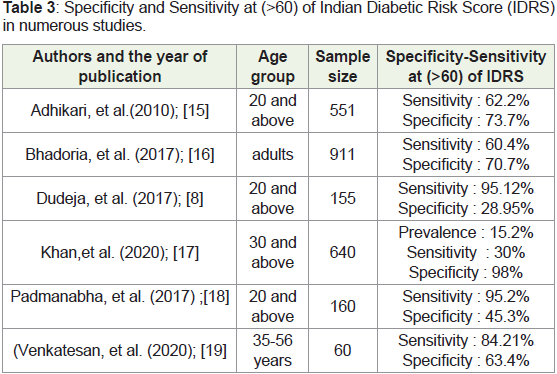Review Article
Indian Diabetic Risk Score: A Non-invasive Tool for Early Screening of Type 2 Diabetes
Mishra S*, Pareek N
Department of Home Science, Banasthali Vidyapith, Jaipur, Rajasthan, India
*Corresponding author: Mishra S, Department of Home Science, Banasthali Vidyapith, Jaipur, Rajasthan, India; E-mail:
mshubhi709@gmail.com
Article Information: Submission: 12/08/2022; Accepted: 10/09/2022; Published: 15/09/2022
Copyright: © 2022 Mishra S, et al. This is an open access article distributed under the Creative Commons Attribution License, which
permits unrestricted use, distribution, and reproduction in any medium, provided the original work is properly cited.
Abstract
The global encumber of type 2 diabetes is escalating each day, and of those affected are still undiagnosed. Early screening of the disease may prove to
be a life saver in overseeing the onset of disease. The Indian Diabetes Risk Score (IDRS) may accommodate in the screening of undiagnosed type 2 diabetes.
IDRS is simple, less time consuming and economic. Early detection followed by educating population, lifestyle management and their implementation may
lessen the overall lumber of disease type 2 diabetes worldwide.
Keywords
Diabetes
Introduction
Diabetes is a severe metabolic state that arises when the body’s
insulin synthesis is disrupted or when the produced insulin is not
used effectively. Type 2 diabetes, despite being entirely preventable,
accounts for the significant number of diabetes cases [1]. The
causes of type 2 diabetes are varying in person to person among
population. It can be managed effectively by supporting, educating,
and encouraging them to adopt a healthy lifestyle [2]. Although, there
is a clear correlation between the type 2 diabetes, overweight, obese,
ethnicity and having family history [3].
Type 1- An autoimmune reaction in which the body’s immune
system targets the pancreas’ insulin-producing beta cells causes type
1 diabetes. As a result, the body produces very little or no insulin [2].
Type 2- Hyperglycaemia in type 2 diabetes is caused by the body’s
cells’ failure to respond properly to insulin, a condition known as
insulin resistance. Insulin resistance causes the hormone to become
less effective, which leads to an increase in insulin production.
Inadequate insulin production can develop over time as a result of the
pancreatic beta cells’ inability to keep up with demand [3].
Global scenario:
Diabetes is seen as a major public health issue as well as a global societal disaster. Diabetes affects 382 million individuals worldwide
and this will increase to 592 million people by 2035 [4]. It has major
consequences, with the quality of life decreasing. According to the
World Health Organization (WHO), diabetes would likely rank
seventh among leading causes of human mortality until 2030 and it
has been identified as a major cause of premature death and illness
around the world. During 2015, diabetes was found in 415 million
people worldwide and estimated further increase of 642 million
people among global population by 2040 [5]. The Diabetes Atlas data
of the year 2016 comes from nations that account for more than 91.2
percent of the worldwide population. Type 2 diabetes is the most
common type of diabetes, accounting for approximately 90% of all
diabetes cases [1].The ninth edition of International Diabetes Federation (IDF) 2019
estimated 463 million cases in the year 2019 and also estimated the
total increase of 51% till the year 2030 [2]. Currently diabetes affected
537 million people globally. The prevalence of diabetes in adults aged
18-99 years was estimated to be 8.4% in 2017 and predicted to rise to
9.9% in 2045 [3].
Indian scenario:
Every fifth diabetic in the planet is an Indian [6]. In 2006, the International Diabetes Federation (IDF) predicted that the number
of diabetic patients in India will climb to 69.9 million by 2025 unless
effective preventative measures were adopted; nonetheless, India
reached virtually that figure (69.1 million) in 2015 [5]. In 2021, India
was placed second in the top ten nations or territories for the number
of adults (20-79 years) with undiagnosed diabetes, trailed by China,
Indonesia, and Pakistan. According to the report, there are 39.4
million (53.1%) people in India who have undiagnosed diabetes [3].India has been dubbed the “Diabetic Capital of the World” due
to its high diabetes incidence. Type 2 diabetes accounts for 85-95
percent of all diabetes cases, and the global epidemic of this illness is
a major health-care burden [7].
India is the world’s diabetes capital, having the highest number
of diabetic sufferers. In the population, there are a significant number
of diabetic cases that are undiagnosed. Type 2 diabetes is caused
by a diet heavy in fat, salt, and sugar, as well as a lack of physical
activity. Other key factors that contribute to the development of type
2 diabetes include the subject’s family history. Lack of knowledge and
understanding about the factors that cause disease increases the risk
and leads to disease development [8].
Significance of early screening and prevention:
Type 2 diabetes, despite being entirely avoidable, accounts for the
great majority of diabetes cases [1]. Many people with type 2 diabetes
are diagnosed after they have begun to experience symptoms. It’s
delayed by the time people get know about the formerly developed
type 2 diabetes in them. This state cannot be reversed it can only be
managed by some lifestyle modifications. So, this state of affair can be
prevented lone by early screening.If early screening is done on time, the prevalence of type 2
diabetes will get significantly reduced. Early detection, understanding
of relevant factors, and the implementation of preventative actions
all collectively contribute towards prevention. As a result of early
diagnosis, individuals are less likely to acquire type 2 diabetes.
Ultimately, this approach may be conducive towards reducing
the new cases. Early screening of diabetes may prevent or slow the
development of complications if active treatment is implemented
early [9].
Early screening can be boon in the prevention of type 2 diabetes as
it may vigilant people by presenting the actual picture. Indian Diabetic
Risk Score (IDRS) is a non invasive tool used for an early screening
of type 2 diabetes. IDRS developed by Madras Diabetes Research
Foundation (MDRS) for making screening programmes most cost
effective [10]. There are plethora of researches and validations quoted
in this article which proves that this tool is entirely fitting for the
screening of the disease as it is simple, quick and less outlay.
Screening tool: IDRS:
The Indian Diabetic Risk Score is a simple method for detecting
type 2 diabetes that hasn’t been diagnosed. This screening tool was
created with simple characteristics in mind to determine the risk of
type 2 diabetes in people of various ages. It is comprised of four simple
parameters: (i) age, (ii) abdominal obesity (waist circumference), (iii) diabetes in the family, and (iv) Physical activity. The screening tool
IDRS was created by MDRS to make screening programmes more
cost effective [11].A maximum score of 100 is given and subjects with an IDRS score
of less than 30 were classified as low risk, those with a score of 30-50
as medium risk and those with a score of more than 60 as high risk
for diabetes. This screening tool is totally non invasive, thrifty and less
time consuming. Such tools are effective in unmasking the true extent
of disease burden.
Relevance of IDRS:
IDRS tool has been used by number of Indian researches to find
out the risk of type 2 diabetes among different age groups. A study
conducted on 1530 adult population for prediction of undiagnosed
type 2 diabetes using IDRS. This screening by IDRS tool categorized
study subjects into 3 categories i.e., low risk (70.4%), medium risk
(19.5%) and high risk (10.1%) population [12]. Another assessed the
risk of type 2 diabetes among rural population in Karnataka by using
IDRS. According to IDRS in this study, 14.84% of the subjects falls
under the category of high risk of type 2 diabetes, 73.19% covered
under the moderate risk category and 11.95% were falling in the
category of low/no risk of type 2 diabetes [13]. Likewise, one more
performed screening for type 2 diabetes in Chennai and concluded
that 18% of the study population had low risk, 45% subjects had
medium risk and 37% of study population had high risk of developing
type 2 diabetes [14].Studies quoted in this article clearly evidenced that the Indian
Diabetic Risk Score is a most suitable non-invasive tool for screening
of type 2 diabetes. Studies indicate that IDRS screening tool used
majorly among adult population of 20 to 40 years age group in both
urban and rural areas. Studies concluded diverse results for each risk
categorization given by IDRS i.e., category of high, moderate and low
risk In a number of studies higher percentage falls under high risk
and several studies revealed data shows higher percentage towards
the category of medium or low risk [15-18] (Table 1-3 ).
Conclusion
Early detection is an imperative necessitate as it may be
conducive towards the prevention process, furthermore delaying the
onset of disease. Plethora of cases remains undiagnosed each year.
Disease cannot be upturned it can merely be managed. IDRS is the
most appropriate and uncomplicated community screening tool for
screening the risk of type 2 diabetes. Screening procedures followed
by implementation of edification will eventually result in decreasing
the overall burden of disease across the globe.



